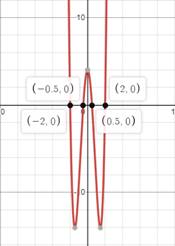
Concept explainers
a.
To find: The possible rational zeroes of the function
a.
Answer to Problem 38E
Possible rational zeroes of the function are
Explanation of Solution
Given information:
Given function is
Formula used:
Rational root test: According to this test, the list of all possible rational zeroes of a polynomial is,
Possible zeroes
Consider the function as,
Here, leading coefficient is
Factors of constant term 4 are
Factors of leading coefficient 4are
Then possible rational zeroes are,
Therefore, possible rational zeroes of the function are
b.
To draw: The graph of the function
b.
Explanation of Solution
Given information:
Given function is
Possible rational zeroes of the function are
Consider the function as
Graph of the function can be drawn as,

From the graph of the function, it is clear that zeroes of the function are
c.
All the real zeroes of the function
c.
Answer to Problem 38E
Real zeroes of the function are
Explanation of Solution
Given information:
Given function
Possible rational zeroes of the function are
Consider the given function as function
From part (a), possible rational zeroes of the function are
From part (b), it is clear is clear that the curve do not touch x − axis at
Hence, real zeroes of the function are
Chapter 2 Solutions
EBK PRECALCULUS W/LIMITS
- 1) Find the equation of the tangent line to the graph y=xe at the point (1, 1).arrow_forward3) Suppose that f is differentiable on [0, 5], and f'(x) ≤ 3 over this interval. If f(0) = −1, what is the maximum possible value of f(5)?arrow_forward2) Find the maximum value of f(x, y) = x - y on the circle x² + y² - 4x - 2y - 4 = 0.arrow_forward
- For the system consisting of the lines: and 71 = (-8,5,6) + t(4, −5,3) 72 = (0, −24,9) + u(−1, 6, −3) a) State whether the two lines are parallel or not and justify your answer. b) Find the point of intersection, if possible, and classify the system based on the number of points of intersection and how the lines are related. Show a complete solution process.arrow_forward3. [-/2 Points] DETAILS MY NOTES SESSCALCET2 7.4.013. Find the exact length of the curve. y = In(sec x), 0 ≤ x ≤ π/4arrow_forwardH.w WI M Wz A Sindax Sind dy max Утах at 0.75m from A w=6KN/M L=2 W2=9 KN/m P= 10 KN B Make the solution handwritten and not artificial intelligence because I will give a bad rating if you solve it with artificial intelligencearrow_forward
- Solve by DrWz WI P L B dy Sind Ⓡ de max ⑦Ymax dx Solve by Dr ③Yat 0.75m from A w=6KN/M L=2 W2=9 kN/m P= 10 KN Solve By Drarrow_forwardHow to find the radius of convergence for the series in the image below? I'm stuck on how to isolate the x in the interval of convergence.arrow_forwardDetermine the exact signed area between the curve g(x): x-axis on the interval [0,1]. = tan2/5 secx dx andarrow_forward
 Calculus: Early TranscendentalsCalculusISBN:9781285741550Author:James StewartPublisher:Cengage Learning
Calculus: Early TranscendentalsCalculusISBN:9781285741550Author:James StewartPublisher:Cengage Learning Thomas' Calculus (14th Edition)CalculusISBN:9780134438986Author:Joel R. Hass, Christopher E. Heil, Maurice D. WeirPublisher:PEARSON
Thomas' Calculus (14th Edition)CalculusISBN:9780134438986Author:Joel R. Hass, Christopher E. Heil, Maurice D. WeirPublisher:PEARSON Calculus: Early Transcendentals (3rd Edition)CalculusISBN:9780134763644Author:William L. Briggs, Lyle Cochran, Bernard Gillett, Eric SchulzPublisher:PEARSON
Calculus: Early Transcendentals (3rd Edition)CalculusISBN:9780134763644Author:William L. Briggs, Lyle Cochran, Bernard Gillett, Eric SchulzPublisher:PEARSON Calculus: Early TranscendentalsCalculusISBN:9781319050740Author:Jon Rogawski, Colin Adams, Robert FranzosaPublisher:W. H. Freeman
Calculus: Early TranscendentalsCalculusISBN:9781319050740Author:Jon Rogawski, Colin Adams, Robert FranzosaPublisher:W. H. Freeman
 Calculus: Early Transcendental FunctionsCalculusISBN:9781337552516Author:Ron Larson, Bruce H. EdwardsPublisher:Cengage Learning
Calculus: Early Transcendental FunctionsCalculusISBN:9781337552516Author:Ron Larson, Bruce H. EdwardsPublisher:Cengage Learning





